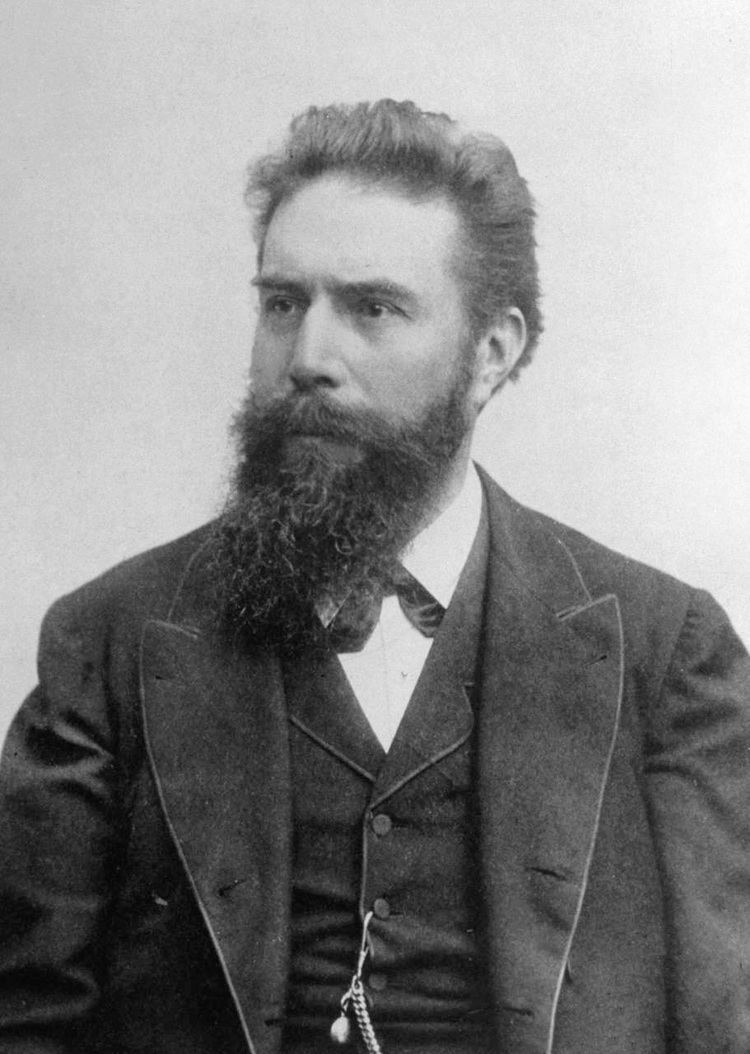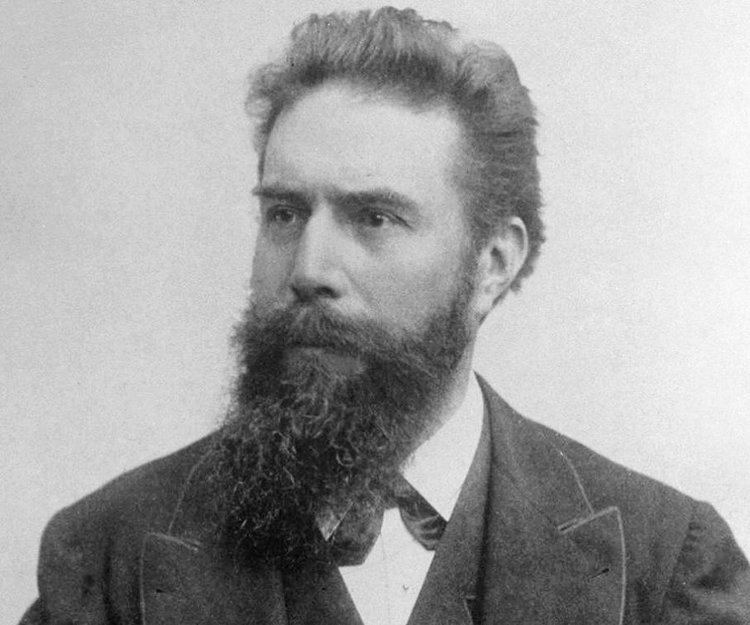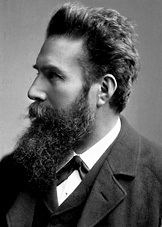Nationality German Children Josephine Bertha Ludwig Role Physicist | Name Wilhelm Rontgen | |
 | ||
Born Wilhelm Conrad Rontgen27 March 1845Lennep, Rhine Province, Germany ( 1845-03-27 ) Fields PhysicsX-ray astronomy Institutions University of StrassburgUniversity of HohenheimUniversity of GiessenUniversity of WurzburgUniversity of Munich Alma mater ETH ZurichUniversity of Zurich Doctoral students Herman MarchAbram IoffeErnst WagnerRudolf Ladenburg Died February 10, 1923, Munich, Germany Spouse Anna Bertha Ludwig (m. 1872–1919) Parents Friedrich Conrad Rontgen, Charlotta Contanza Frowein Books Rontgen Rays: Memoirs by Rontgen, Stokes, and J. J. Thomson Similar People | ||
Episode 1 the man who had x ray vision wilhelm rontgen 1901
Wilhelm Conrad Röntgen (/ˈrɛntɡən, -dʒən, ˈrʌnt-/; [ˈvɪlhɛlm ˈʁœntɡən]; 27 March 1845 – 10 February 1923) was a German/Dutch mechanical engineer and physicist, who, on 8 November 1895, produced and detected electromagnetic radiation in a wavelength range known as X-rays or Röntgen rays, an achievement that earned him the first Nobel Prize in Physics in 1901. In honour of his accomplishments, in 2004 the International Union of Pure and Applied Chemistry (IUPAC) named element 111, roentgenium, a radioactive element with multiple unstable isotopes, after him.
Contents
- Episode 1 the man who had x ray vision wilhelm rontgen 1901
- First x ray rontgen rays wilhelm rontgen
- Education
- Career
- Personal life
- Honors and awards
- Legacy
- References

First x ray rontgen rays wilhelm rontgen
Education

Born to a German father and a Dutch mother, he attended high school in Utrecht, Netherlands. In 1865 he was expelled from high school when one of his teachers intercepted a caricature. Without a high school diploma, Röntgen could attend university in the Netherlands, but only as a visitor. In 1865, he tried to attend Utrecht University without having the necessary credentials required for a regular student. Upon hearing that he could enter the Federal Polytechnic Institute in Zurich (today known as the ETH Zurich), he passed its examinations, and began studies there as a student of mechanical engineering. In 1869, he graduated with a Ph.D. from the University of Zurich; once there, he became a favorite student of Professor August Kundt, whom he followed to the University of Strassburg (then recently annexed by Germany) in 1873.
Career

In 1874 Röntgen became a lecturer at the University of Strassburg. In 1875 he became a professor at the Academy of Agriculture at Hohenheim, Württemberg. He returned to Strassburg as a professor of physics in 1876, and in 1879, he was appointed to the chair of physics at the University of Giessen. In 1888, he obtained the physics chair at the University of Würzburg, and in 1900 at the University of Munich, by special request of the Bavarian government.

Röntgen had family in Iowa in the United States and at one time planned to emigrate. Although he accepted an appointment at Columbia University in New York City and had actually purchased transatlantic tickets, the outbreak of World War I changed his plans and he remained in Munich for the rest of his career.

During 1895 Röntgen was investigating the external effects from the various types of vacuum tube equipment — apparatuses from Heinrich Hertz, Johann Hittorf, William Crookes, Nikola Tesla and Philipp von Lenard — when an electrical discharge is passed through them. In early November, he was repeating an experiment with one of Lenard's tubes in which a thin aluminium window had been added to permit the cathode rays to exit the tube but a cardboard covering was added to protect the aluminium from damage by the strong electrostatic field that is necessary to produce the cathode rays. He knew the cardboard covering prevented light from escaping, yet Röntgen observed that the invisible cathode rays caused a fluorescent effect on a small cardboard screen painted with barium platinocyanide when it was placed close to the aluminium window. It occurred to Röntgen that the Hittorf-Crookes tube, which had a much thicker glass wall than the Lenard tube, might also cause this fluorescent effect.
In the late afternoon of 8 November 1895, Röntgen was determined to test his idea. He carefully constructed a black cardboard covering similar to the one he had used on the Lenard tube. He covered the Hittorf-Crookes tube with the cardboard and attached electrodes to a Ruhmkorff coil to generate an electrostatic charge. Before setting up the barium platinocyanide screen to test his idea, Röntgen darkened the room to test the opacity of his cardboard cover. As he passed the Ruhmkorff coil charge through the tube, he determined that the cover was light-tight and turned to prepare the next step of the experiment. It was at this point that Röntgen noticed a faint shimmering from a bench a few feet away from the tube. To be sure, he tried several more discharges and saw the same shimmering each time. Striking a match, he discovered the shimmering had come from the location of the barium platinocyanide screen he had been intending to use next.
Röntgen speculated that a new kind of ray might be responsible. 8 November was a Friday, so he took advantage of the weekend to repeat his experiments and make his first notes. In the following weeks he ate and slept in his laboratory as he investigated many properties of the new rays he temporarily termed "X-rays", using the mathematical designation ("X") for something unknown. The new rays came to bear his name in many languages as "Röntgen Rays" (and the associated X-ray radiograms as "Röntgenograms").
At one point while he was investigating the ability of various materials to stop the rays, Röntgen brought a small piece of lead into position while a discharge was occurring. Röntgen thus saw the first radiographic image, his own flickering ghostly skeleton on the barium platinocyanide screen. He later reported that it was at this point that he determined to continue his experiments in secrecy, because he feared for his professional reputation if his observations were in error.
Nearly two weeks after his discovery, he took the very first picture using X-rays of his wife Anna Bertha's hand. When she saw her skeleton she exclaimed "I have seen my death!"
Röntgen's original paper, "On A New Kind Of Rays" (Über eine neue Art von Strahlen), was published on 28 December 1895. On 5 January 1896, an Austrian newspaper reported Röntgen's discovery of a new type of radiation. Röntgen was awarded an honorary Doctor of Medicine degree from the University of Würzburg after his discovery. He published a total of three papers on X-rays between 1895 and 1897. Today, Röntgen is considered the father of diagnostic radiology, the medical speciality which uses imaging to diagnose disease.
A collection of his papers is held at the National Library of Medicine in Bethesda, Maryland.
Personal life
Röntgen was married to Anna Bertha Ludwig (m. 1872, d. 1919) and had one child, Josephine Bertha Ludwig. Adopted at age 6, in 1887, she was the daughter of Anna's brother. Röntgen died on 10 February 1923 from carcinoma of the intestine.
He inherited two Million Reichsmarks after his father's death. With the inflation following World War I, Röntgen fell into bankruptcy later in life, spending his final years at his country home at Weilheim, near Munich. In keeping with his will, all his personal and scientific correspondence was destroyed upon his death.
Honors and awards
In 1901 Röntgen was awarded the very first Nobel Prize in Physics. The award was officially "in recognition of the extraordinary services he has rendered by the discovery of the remarkable rays subsequently named after him". Röntgen donated the monetary reward from his Nobel Prize to his university. Like Pierre Curie, Röntgen refused to take out patents related to his discovery, as he wanted mankind as a whole to benefit from practical applications of the phenomenon.
His honors include:
In 1907 he became a foreign member of the Royal Netherlands Academy of Arts and Sciences.
Legacy
Today, in Remscheid-Lennep, 40 kilometres east of Düsseldorf, the town in which Röntgen was born in 1845 is the Deutsches Röntgen-Museum.
In Würzburg, where he discovered the X-Rays, a non-profit organization maintains his laboratory and provides guided tours to the Röntgen Memorial Site.
